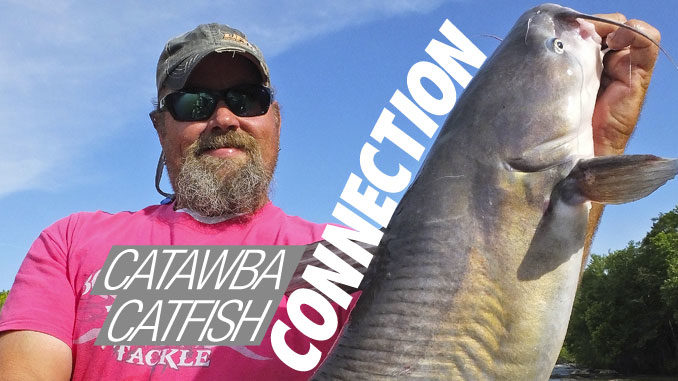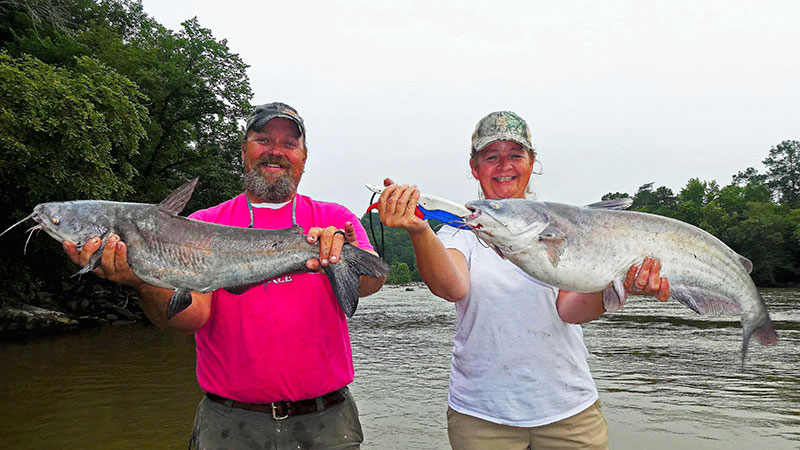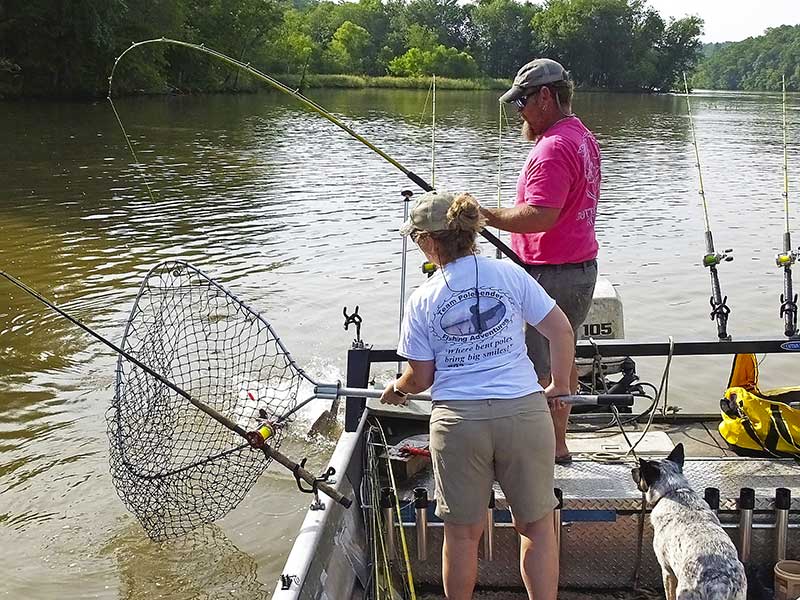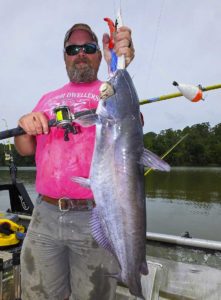
The catfish population boom and the subsequent surge of catfishing popularity has encompassed waters throughout South Carolina, but the explosion in the Catawba River system has been phenomenal.
The South Carolina portion of the Catawba River includes Lake Wateree, Stumpy Pond, Fishing Creek Lake and a significant portion of Lake Wylie.
Guide Scott Peavy from Blythewood, S.C., operates Polebender Fishing Adventures; he targets all of these lakes year-round and said the catfishing is outstanding, and both day and night offer excellent fishing opportunities.
“August is a prime time to load up on fast-paced action at any of these Catawba River lakes if fishermen have a good strategy for fishing conditions,” he said.
Peavy, 42, said each lake is unique in terms of hot-weather catfish action.
Lake Wateree
Wateree is one of Peavy’s “go-to” lakes for summer action, in part because of the diversity of fishing patterns and targets.
“Wateree is a fertile lake, producing excellent fishing for numbers as well as trophy-sized blue catfish,” he said, “but the lake is producing increasing flathead action, and I think flatheads will expand here.”
Peavy (803-569-7917) said Wateree’s 13,700 surface acres provide diverse fishing opportunities, and one prime example occurs after a heavy rain.
“A major summer rain event causing lots of water to be released from the Cedar Creek Dam at the upper end of Lake Wateree attracts catfish in big numbers, and the fishing can be awesome,” Peavy said. “The first couple of miles below the dam will provide sensational fishing under these conditions.”

Peavy said his typical summer pattern on Wateree during periods of normal weather is fishing flats from the middle part of the lake down to the lower end in 12 to 20 feet of water. He also targets humps, points, channel ledges and deep holes.
“I generally anchor-fish, but during the summer, I’ll also drift-fish the flats,” he said. “I’ll fish around mussel beds where catfish congregate during July and August. My favorite bait on Wateree in mid-summer is a 5- to 6-inch white perch with the tail cut off and one side filleted, leaving it connected to flap and create scent. Gizzard shad chunks are also very good.”
Sutton’s Landing near Lake Wateree State Park in Taylor Creek usually has plenty of live and fresh bait available, he said.
Peavy said when he finds a productive stretch, he’ll go back and repeat the drift, day or night.
“I’ve drifted areas in this depth range on 100-degree days and just be killing the catfish in the 14- to 16-pound range,” he said. “Wateree is one of my favorite catfishing lakes anytime,” he said. “The big fish potential here, especially for blues, is outstanding,” he said.
Stumpy Pond
Impounded by Cedar Creek Dam at the upper end of Lake Wateree, this lake is primarily known as Stumpy Pond and encompasses 847 surface acres of water. Despite its smallish size, this lake packs a powerful catfish punch.
“Stumpy Pond is an appropriate name, and fishermen have to be careful where they run boats wide open,” he said. “But this also means most of the motorized boating traffic is by fishermen.
“When I find moving water in this lake, I’ll go to the current in the upper end of the lake for catfish.”
When flow is not significant, Peavy targets more typical areas such as large flats in 10 to 20 feet of water. He also fishes the eddy sides of points, deep holes scoured out by current and mid-lake high spots.
Peavy said the lake’s size creates unique opportunities for fishermen.
“Because of the size of the lake, a heavy afternoon storm can create a short-term but significant water flow into the upper end, creating excellent catfishing conditions,” he said.
“Stumpy Pond produces a lot of catfish, but I’m high on the big-fish potential here,” Peavy said. “It wouldn’t surprise me to see a record-sized catfish caught from this lake. Stumpy Pond has huge numbers of shad, perch and bream for forage, and the catfish have the potential to grow huge.”
Fishing Creek Lake
Fishing Creek has morphed into an excellent fishery, with a long-standing channel catfish population and an excellent blue catfish fishery for several years.

“It’s now becoming a really good flathead fishery, and they’re showing up regularly in catfish tournaments,” Peavy said. “Even if targeting blue catfish, flatheads often load on.”
Fishing Creek’s 3,112 surface acres of water are only part of the fishing options. Peavy said the lake is similar to Stumpy Pond in that after heavy rains, fishermen can go up the river and catch catfish feeding in the current. During normal conditions, it’s similar to Lake Wateree in terms of fishing the main-lake area and targeting drops, flats, points and channels.
“I generally fish depths from 6 to 18 feet here, fairly shallow due to the water having pretty good oxygen content,” Peavy said. “The water tumbles down the Catawba River from Lake Wylie Dam to Fishing Creek, and I think that helps the oxygen level.
“I catch flatheads and blues on fresh cut shad or perch, but live bait is fine as well,” he said. “I’m excited about the big-fish potential on this lake, with fish over 60 pounds having been caught in tournaments. A lot of big fish are in this lake.”
Lake Wylie
Lake Wylie’s 13,400 surface acres are split between the Carolinas, but much of the lower end of the lake lies in South Carolina, offering prime summer fishing.
Peavy said that opting to get an out-of-state fishing license for North Carolina will significantly expand a fisherman’s potential to catch fish.
“Lake Wylie is a fantastic fishery for the big three catfish species,” he said. “A unique opportunity is the realistic potential to catch the Grand Slam of catfish — channel, blue and flatheads — on the same trip.”
Peavy said the primarily drawback for August catfishing is the tremendous amount of non-fishing, recreational boating traffic.
“I generally fish Wylie at night in the summer because the daytime boat traffic is so congested,” he said. “But from daylight until 9 o’clock, fishermen have a small window of opportunity.
“I like fishing deep holes surrounded by shallow water when night fishing,” he said. “And the same type targets described for Lake Wateree for blue catfish — mussel beds, humps, points and channel ledges — are excellent.”
Peavy said big fish potential is off the charts at Lake Wylie, because both blue and flathead catfish grow to enormous sizes, with blue catfish over 80 pounds having been caught.
Float rig for bonus catfish
Guide Scott Peavy employs a float rig for summer catfish at all of the Catawba River lakes in South Carolina, and he said it produces bonus fish.

“Catfish often suspend during the summer,” Peavy said. “If I’m only fishing baits on the bottom, I’m missing some excellent fish-catching opportunities.”
He said a depth-specific float works, but he prefers a slip-float rig so he can easily set and change the depth when necessary.
Peavy uses is an egg-shaped float, slightly larger than a large egg, that slides on the line and stops at a bobber stopper. He has an 18- to 24-inch leader with a 7/0 or larger circle hook and adds enough weight above the swivel to keep the bait in the target zone. He uses a 71/2-foot, medium-heavy Mustard rod.
“Fish suspend for various reasons, but forage availability is certainly one,” Peavy said. “Presenting the bait at the depth fish are suspended enables me to target these fish.
“I may be fishing a flat that’s 12 to 30 feet deep and marking a lot of fish suspended in the water column well off the bottom,” he said. “With this rig, I can work baits at any depth.
“When fishing current-flow situations during the summer, I’m usually in shallow water, and this rig also enables me to float a bait down the current just off the bottom to keep it in the strike zone. Sometimes in these situations, I may not use any additional weight other than a swivel.”





Be the first to comment